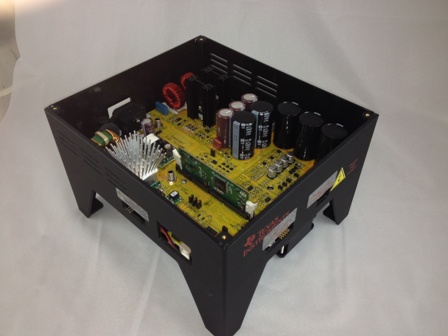Podcast: Play in new window | Download
Subscribe: Apple Podcasts | RSS
- Links discussed sourced from the /r/TheAmpHour subreddit:
- Analog TV ends in Australia
- What should Dave do with his Sinclair C5?
- New seminar, the “Hardware Workshop” will teach you how to start a hwstartup.
- Pinocc.io Discusses Testing Before Shipping
- How do you track your revisions for hardware builds?
- Adding test functionality to your PCB Panel
- CotW: A resistor. A very expensive resistor.
- C’mon Digikey, You’re Falling Behind (Amazon is developing drones for fast delivery)
- Stratasys sues 3D printer maker Afinia
- Dave hit 100,000 Youtube subscribers!
- Links talked about in the course of the show:
- The TI TMS320C2000 Development Kit for high voltage motor applications (shown above). More about the motor application and all the math here.
- Amazon’s factories run with robots that bring shelves to the people that pack and pick items at the warehouse.
Remember, next week on the show we’ll have Andrew Witte, CTO of Pebble Technologies (creators of the Pebble smartwatch). Get your questions in here!
Photo courtesy of TI


well you both were kinda right on the C2000: The wanker term for these chips (alike dsPICs and the Cortex M4 micros) ist DSC (Digital Signal Controller) which refers to micros with enhanced DSP capabilities for dsp heavier application that are hard to do on a standart micro, but don’t need/allow the use of a fancy DSP with large external memory
What is interesting is that the C2000 family was born as a DSP, which it truly is (it has specialized DSP hardware all over its internal core). However, some years ago TI decided to market it as a microcontroller, which it also is (it has zillions of peripherals just like any uC). One of these grey area devices that merge the best of two worlds… 🙂
Chris has discovered VFD’s. Here is my favorite one I have been using for a few years. They are dumb simple to use and cheap. I think I spent under $90 each for the KBVF-13 which handles up to 1/2 HP and runs 120 to 3 phase 208 or 240 from 0 RPM to double nameplate RPM. They are fun to play with.
The laser printing patent will be expiring in Feb.2014 so still valid as of today
We tried using our MRP system for keeping track of our BOM’s and it didn’t work and we tried using spreadsheets and they didn’t work. The BOM output of our PCB CAD software was useless. We finally settled on using Parts&Vendors http://www.trilogydesign.com.
I’m looking forward to ordering a book from Amazon and getting my free quadcopter!
I love it when in an episode Chris or Dave act super excited about something I look at almost everyday. The last time was on the episode where you guys talked about the Tesla motors factory. I work in an automotive plant so seeing and working on automation robotics and huge presses and variable frequency drives (VFDs) is nothing new to me anymore.
Here you are in fields I think are fascinating all the while I am working with equipment that fascinates and seems novel to you. Can we switch for a few days?
Ditto. Wow. I better be careful with that word. It’s an antique!
Sure, sign me up! Might take a bit more than “a few days” though
I think GitFlow can also work for hardware designs, there’s an overview/cheatsheet here: http://danielkummer.github.io/git-flow-cheatsheet/
Major hardware releases (PCB revs) can be tied to releases on the master branch, the development branch (and feature branches) can be used to make changes etc. Maybe a folder for hardware, software and documentation, then everything related to the project is in version control and you have a snapshot for each revision of everything.